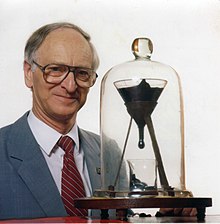Pitch drop experiment

The pitch drop experiment is a long-term experiment to observe the dropping behavior of pitch , a super viscous substance at room temperature that is apparently a solid .
execution
In 1927 Thomas Parnell , professor at the University of Queensland in Brisbane , Australia, began preparing for the experiment . He poured heated pitch into a funnel with a closed bottom and gave the material three years to set. In 1930 the funnel was opened and the pitch began to flow.
The first drop fell in 1938, and others followed in 1947, 1954, 1962, 1970, 1979, 1988, 2000 and 2014.
The experiment does not take place under controlled conditions. In particular, temperature fluctuations over the decades have an influence on the drop sequence. The installation of an air conditioner only messed up the experiment because instead of warm summers and cold winters, there were now warm winters and cold summers. As a result, the drop from 2000 did not come off in summer, but in winter. It was also so big that there was not enough space between the funnel and beaker to drain.
Up to the ninth drop, which fell in April 2014, no falling drop could be observed, because at the respective times one eye was never on the experiment, or the webcam , which had been installed to observe the experiment since the 1990s, was at Fall of the penultimate drop failed on November 28, 2000. A film was finally made of the ninth drop in 2014 when it hit the ground. However, it still remains connected to the funnel, just as the eighth drop had not yet completely dissolved by 2014.
In a similar experiment, which was started at Trinity College in Dublin in October 1944, it was already possible to film a falling drop in July 2013.
Awards
In 2003 it was included in the Guinness Book of Records as the "longest-running laboratory experiment" in the world.
For their scientific achievement, Thomas Parnell (posthumously) was awarded the satirical Ig Nobel Prize in 2005 in the physics category, together with John Mainstone , who led the experiment after Parnell's death .
chronology
The first report on the tar droplets appeared in a newspaper in 1976. Another eight years passed before the scientific paper was published.
In the foyer of the Faculty of Physics at the University of Queensland in Brisbane, the "pitch drop" experiment is being carried out to demonstrate the fluidity and very high viscosity of pitch for teaching purposes. It was started in 1927 by Professor Thomas Parnell, the first professor of physics the college, was launched.
| date | event | Duration (months) |
|---|---|---|
| 1927 | Experiment was prepared | |
| 1930 | Funnel was opened | |
| December 1938 | 1st drop fell | 96-107 |
| February 1947 | 2nd drop fell | 99 |
| April 1954 | 3rd drop fell | 86 |
| May 1962 | 4th drop fell | 97 |
| August 1970 | 5th drop fell | 99 |
| April 1979 | 6. Drop fell | 104 |
| July 1988 | 7th drop fell | 111 |
| November 28, 2000 | 8th drop fell | 148 |
| April 2014 | 9. Drop fell | 158 |
See also
- Droplet Photography - Photographing fast drops
literature
- Bernd Schröder: The longest experiment - almost halfway through the discovery of slowness . In: Telepolis of September 29, 2004.
- Reto U. Schneider: The most boring experiment in the world . In: NZZ Folio . July 2008, p. 59 ( online [accessed August 6, 2019]).
Web links
- The Tenth Watch - Live webcam
- Video of the ninth drop
- University of Queensland - The pitch drop experiment (English)
- University of Queensland - The pitch drop experiment , with pictures and viscosity calculation
- Video Ask den Lesch: The world's most boring experiment (broadcast on October 31, 2011, 1:15 a.m., 1:50 p.m.) in the ZDFmediathek , accessed on February 6, 2014.
Individual evidence
- ↑ a b c d e f g h i R. Edgeworth, BJ Dalton, T. Parnell: The pitch drop experiment . In: European Journal of Physics . tape 5 , no. 4 , 1984, pp. 198-200 , doi : 10.1088 / 0143-0807 / 5/4/003 .
- ↑ a b Pitch drop touches down - oh so gently. The University of Queensland, April 17, 2014, accessed April 19, 2014 .
- ^ Robin McKie: World's oldest and stickiest lab study ready for drop of excitement. In: The Guardian .com. April 27, 2013, accessed May 1, 2013 .
- ↑ Pitch Drop Time Lapse 2 years to date. In: YouTube.com. The University of Queensland, April 16, 2014, accessed April 19, 2014 .
- ↑ Lisa Grossman, Celeste Biever: Longest experiment sees pitch drop after 84-year wait . In: New Scientist . No. 2966 , April 2014 ( online [accessed April 17, 2014]).
- ^ Trinity College experiment succeeds after 69 years. In: RTÉ.ie ( Raidió Teilifís Éireann , Dublin). July 24, 2013, accessed August 5, 2019 .
- ^ Richard Johnston: World's slowest-moving drop caught on camera at last . In: Nature . July 18, 2013, doi : 10.1038 / nature.2013.13418 .
- ↑ Reto U. Schneider: The most boring experiment in the world . In: NZZ Folio . July 2008, p. 59 ( online [accessed August 6, 2019]).
- ^ The 2005 Ig Nobel Prize Winners. In: Improbable.com. Accessed August 6, 2019 .
- ↑ Mark Benecke: Laughing Science: From the secret archives of the fun Nobel Prize . Bastei Lübbe, Cologne 2005, ISBN 978-3-404-60556-9 , p. 81 ff .
- ^ The pitch drop experiment. In: R. Edgeworth, BJ Dalton, T. Parnell, Department of Physics, University of Queensland, St. Lucia, Queensland, Australia. January 19, 1984. Retrieved November 21, 2019 .

